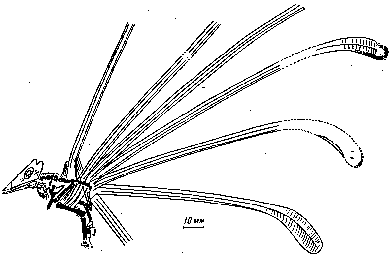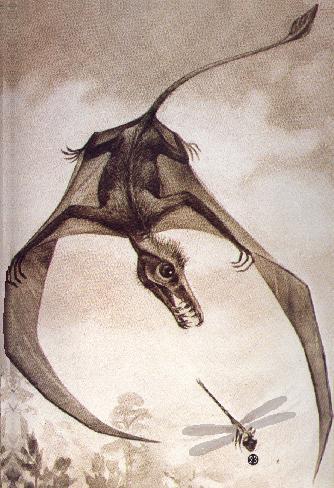
 |
Wings on Hind Legs |
 or
or  ?
?
Wings of birds and bats are actually front legs that were transformed for flying. Wings of pterodactyles also originated from front legs. But Sharovipterix had wings on its hind legs! Bone structure indicates that Sharovipterix could not be an active flyer. But it could be a glider. Dr. Allan Edward Munro thinks that its front legs are too small for climbing trees. It is also possibile that Sharovipterix jumped as a grasshopper and used the membrane for maneuvering in the air and for extenting the jump. The membrane could be used also for display. Detailed information on the evolution of flight in animals can be found at UC Museum of Paleontology, Berkley.

| Sharovipterix (initially discribed as Podopterix) was discovered by my father, Alexander Sharov in 1960-s. My father was interested mostly in fossil insects (see review), but occasionally he found small reptiles and pterosaurs that were fossilized together with insects. |
These are remains of the Sharovipterix mirabilis and the reconstruction of an animal.


| Sharovipterix mirabilisClick this button to see photos |
Longisquama insignis, had long paired feather-like scales on its back which could be used for parachuting and/or display. John Ruben of Oregon State University thinks that scales of Longisquama are real feathers, and that Longisquama could be a bird ancestor (see Science, June 2000, pp. 2124 and p2202). Longisquama pre-dates Archaeopteryx by 75 million years and may provide new insight into the evolution of modern birds.

| Longisquama insignisClick this button to see photos |

For additional information on Longisquama see:
http://www.menunkatuck.org/longis.html
http://www.orst.edu/dept/ncs/newsarch/2000/Jun00/birds.htm
http://www.mathematical.com/dinolongi.html

Sordes pilosus
These examples show numerous attempts of vertebrate animals to fly.